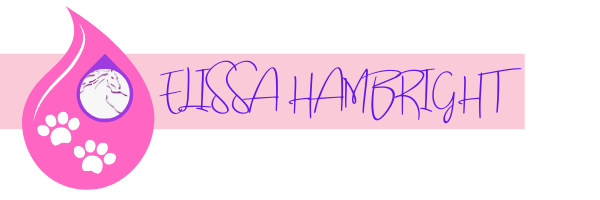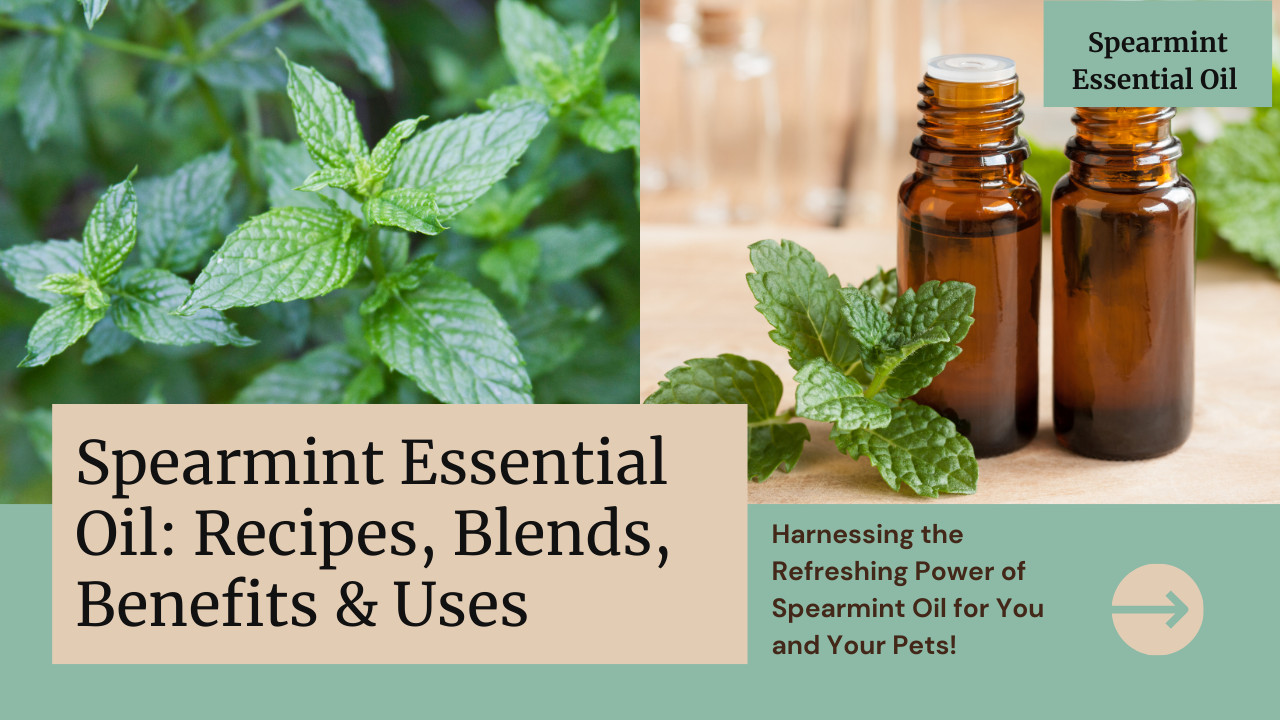
As a horse and dog mom, I've come to appreciate the power of natural remedies, especially when it comes to my dog, Tuli. She tends to experience discomfort during car rides, especially to the vet. Since incorporating spearmint oil into our routine, she has been much more comfortable. This experience is just one example of the many benefits of spearmint essential oil, derived from the aromatic leaves of the spearmint plant (Mentha spicata). Renowned for its wide range of properties and uses for wellness benefits, spearmint oil offers a variety of uses that make it a smart investment for anyone seeking holistic wellness solutions. In this blog post, I'll delve into not only how spearmint oil can benefit you, but also how it can be used safely and effectively for your horses and dogs, along with some of my favorite ways to use spearmint.
Understanding Essential Oils: Nature's Potent Extracts
Essential oils are highly concentrated extracts derived from the natural power of plants. They are extracted from various parts of plants and they capture the plant's scent, flavor, and beneficial properties, making them potent tools for natural health and wellness.
Spearmint (Mentha spicata) is a member of the mint family and a perennial herb known for its refreshing aroma and wellness properties. The oil is extracted from the leaves of the spearmint plant through a process of steam distillation, preserving its natural properties. Spearmint oil is revered for its cooling effect, which can help soothe discomfort when applied topically. Spearmint oil's minty, fresh scent can be particularly beneficial when experiencing digestive discomfort, or in helping to promote mental clarity. Its versatility extends to respiratory health, making it a great addition to any essential oil collection.
While in some cases, depending upon the essential oil you are using and your level of experience, it may be ok to use undiluted oils. However, best practice is to dilute essential oils before use to prevent skin irritation and ensure safe absorption by the body. Organic fractionated coconut oil is a popular choice for dilution, as it serves as an excellent carrier oil for essential oils like spearmint. Its light, less greasy, and absorbs quickly into the skin.
If you are using the essential oil with your horses and dogs, its always a good idea to dilute.
When selecting essential oils, quality is paramount. Look for oils that are pure and free from additives or synthetic ingredients. High-quality and premium essential oils will be more effective and less likely to cause adverse reactions. Avoid oils labeled as 'fragrance oils,' as these are synthetic and do not offer the same wellness benefits as true essential oils. It's also advisable to look for oils that are third-party tested or certified by reputable organizations, as this can further validate their quality and purity.
For a guarantee of purity, I personally recommend checking out my company's essential oils HERE, which are backed by their Seed to Seal® guarantee. I've visited their farms, participated in planting and harvesting, and can attest to their transparency and commitment to quality. This level of involvement and transparency sets them apart, ensuring that I never have to worry about the purity of the oils I purchase from them.
Benefits of Spearmint: More Than Just a Fragrance
Spearmint oil offers a wealth of benefits beyond its delightful aroma. One of its most notable qualities is its cooling effect, which makes it an excellent choice for soothing muscle discomfort and joints. Whether you've overexerted yourself during a workout or simply need to unwind after a long day, a massage blend containing spearmint oil can provide much-needed support. I will often add a couple of tablespoons of Epsom salts to a 5 gallon bucket, add 5 drops of spearmint oil and 5 drops of peppermint oil, then fill up with water and sponge my horse off after exercise. It's perfect to support the body after a hard workout. You could do the same thing to your bath water at the end of a long day.
In addition to its physical benefits, spearmint oil is also valued for its ability to promote mental clarity and alertness. The invigorating scent of spearmint can help support focus and concentration, making it a valuable tool for study sessions or workdays that require heightened cognitive function.
I enjoy inhaling the aroma of spearmint from the bottle before my riding lessons. This ritual helps me tune in and focus, which is also especially helpful in working equitation when at a show, where memorizing tests and obstacles is key. I do find that the aroma enhances my ability to concentrate and remember.
Spearmint oil's benefits extend to the digestive system as well. The aroma of spearmint oil can help promote soothing feelings during stomach discomfort and may support healthy digestion.
Spearmint oil can also be helpful for the respiratory and immune system and is a great choice for an essential oil diffuser blend.
Diffusing Spearmint
Diffusing spearmint oil is a great way to enjoy its fresh, minty aroma and benefit from its refreshing scent. The scent can be particularly soothing during moments of digestive discomfort, offering a sense of wellness. Personally, I find it helpful to diffuse spearmint in the car when traveling with my dog, Tuli, especially to the vet, as she tends to experience discomfort during car rides. Since incorporating this into our routine, she has been much more comfortable. For a simple car diffuser, add a drop or 2 of essential oil onto a cotton ball and place in your air vent.
While you can simply smell spearmint oil from the bottle, creating an essential oil blend with spearmint not only enhances the aromatic experience but also combines the unique properties of each oil for a synergistic effect. These blends can help uplift your mood, promote relaxation, enhance focus, or provide seasonal support, depending on your needs.
Spearmint is classified as a top note in aromatherapy, which means it is one of the first scents you notice when you smell an essential oil blend. Top notes are typically light, fresh, and uplifting, and they tend to evaporate quickly. You can combine spearmint with a middle note and base note for a balanced blend, or blend it with other top notes like citrus oils.The sky's the limit to creating an array of exciting recipes!
Here are some of my go to diffuser blends:
Car Ride Diffuser Blend:
- Spearmint essential oil
- Ginger essential oil
Add a drop of each to a cotton ball and stick in your air vent.
Home Diffuser Blends
1. Energizing Blend
- 3 drops Spearmint
- 3 drops Lemon
2. Relaxing Blend
- 2 drops Spearmint
- 2 drops Lavender
- 2 drops Ylang Ylang
3. Focus Blend
- 3 drops Spearmint
- 2 drops Rosemary
- 1 drop Frankincense
4. Breath Of Fresh Air
- 2 drops Spearmint
- 2 drops Juniper Berry
- 2 drops Lemon
Topical Application
Another great choice to enjoy the benefits of spearmint oil is through topical application. By diluting spearmint oil in a carrier oil, such as organic fractionated coconut oil or jojoba oil, you can create a blend with a pleasant aroma that can also promote overall wellness. Applying this blend to the upper chest can help support airways, making it ideal for respiratory support. You can also apply this to your stomach for digestive support or even the upper throat area to support all levels of digestion.
Enhancing your personal care products with spearmint oil is another simple yet effective way to enjoy spearmint oil. For instance, a great option would be to add it to your lotion or shampoo. One of my favorite blends involves adding 10 drops of spearmint, 5 drops of rosemary, and 10 drops of blue tansy to my natural shampoo. The best part is that this combination is really refreshing for first thing in the morning but equally relaxing for showers at night. The addition of blue tansy and rosemary can help promote scalp health.
As a massage therapist, creating massage blends with spearmint is another favorite way of mine to use this essential oil. It comes in handy with my horses and dogs too. Here are 3 of my favorite blends with spearmint that I've used over the years. I like to use an organic fractionated coconut oil base as the carrier as it's light, non greasy and absorbs well.
Horse Muscle Support Blend:
- 10 drops Lavender essential oil
- 10 drops spearmint essential oil
- 10 drops copaiba essential oil
- 5 drops peppermint essential oil
- 5 drops wintergreen essential oil
- Dilute in a 4 ounces of a carrier oil of your choice
Soothing Tummy Blend For Dogs:
- 3 drops Peppermint oil
- 2 drops spearmint oil
- 2 drops ginger oil
- Dilute in 2 ounces of carrier oil of your choice
Energizing Blend For People:
- 3 drops spearmint essential oil
- 2 drops lemon essential oil
- 2 drops black pepper essential oil
- 5 drops basil essential oil
- Dilute in 2 ounces of carrier oil of your choice
You can also make essential oil roll-ons for topical use. Use rollerball blends as a convenient way to have essential oils pre-diluted for use with your dogs and horses, and also for when you are on the go.
I love to make and use this tummy tamer rollerball blend for travel, as you never know what eating unfamiliar foods can do-haha!
Tummy Tamer Rollerball Blend:
- 5 drops Ginger
- 5 drops Peppermint
- 5 drops Spearmint
- Fill the rest of the rollerball with a carrier oil like fractionated coconut oil.
As A Supplement
And yes, spearmint is also suitable for internal use. Spearmint essential oil is generally recognized as safe (GRAS) by the FDA, meaning it is considered safe for consumption when used appropriately. You may already be ingesting essential oils unknowingly, as they are common in gums, beverages, and as preservatives. However, it's crucial to only use an essential oil labeled for consumption to ensure its purity and safety. If you're not comfortable ingesting essential oils, there are plenty of other ways to enjoy the benefits of spearmint essential oil.
One of my favorite go-to drinks during hot summer days is a refreshing Spearmint Limeade. This twist on classic lemonade offers a burst of flavor that's perfect for recharging after a day of grooming and training at the barn. I like 2 drops but you can add more to suit your desired taste.
Spearmint Limeade:
- 1/2 cup fresh lime juice
- 4 cups cold water
- 1/4 cup honey
- 2 drops Spearmint essential oil labeled for ingestion
- fresh spearmint leaves (optional if available and fun)
Instructions:
- Add the honey to a pitcher and add the 2 drops of Spearmint essential oil, stir to combine.
- Add lime juice and water and stir until the honey is dissolved.
- Serve over ice and garnish with fresh mint leaves, if desired.
Enjoy this refreshing drink on a hot day or as a zesty accompaniment to your favorite summer meal!
Spearmint essential oil is a great addition with a potential powerhouse of wellness benefits that deserves a place in every natural remedy toolkit.
Whether you're looking to create a refreshing diffuser blend, a soothing massage blend, or use it with your horses and dogs, spearmint oil can be seamlessly incorporated into your daily routine.
Ready to experience the refreshing benefits of spearmint oil? Click HERE to grab your bottle today! By purchasing through this link, you're not only taking a step towards holistic wellness but also supporting my work. Plus, it won't cost you anything extra! So why not harness some plant therapy and incorporate spearmint oil into your daily routine?

Young Living's™ Melrose™ essential oil blend is a powerful blend of essential oils known for their cleansing and skin-supporting properties. This blend contains a combination of Melaleuca alternifolia (Tea Tree oil), Melaleuca quinquenervia (Niaouli oil), Rosmarinus officinalis (Rosemary oil), and Syzygium aromaticum (Clove oil). This powerful combination is renowned for its ability to support skin health and may help improve the appearance of skin, making it a valuable addition to your skincare routine. The benefits of the Melrose blend extend beyond just physical wellness; they also encompass emotional well-being. It's also a favorite in my dog and horse first aid kit, and we'll explore why!
Let's take a deeper look into the four different essential oils that make up Young Living's™ Melrose™ oil. Each of these essential oils brings its own unique benefits to the blend, working together to create a powerful and versatile oil that may support skin health. From the cleansing properties of Tea Tree oil to the stimulating aroma of Rosemary oil, let's explore the key aspects of each oil in the Melrose blend.
- Tea Tree Oil (Melaleuca alternifolia): Known for its powerful cleansing properties, Tea Tree oil is commonly used in skincare for its ability to support clear, healthy skin. By the way, tea tree oil is one of my go-to oils for horses and dogs. If you're interested in learning more about using tea tree oil with horses, check out my blog post HERE. For tips on using tea tree oil with dogs, you can visit my dog blog HERE.
- Melaleuca quinquenervia: This essential oil is also known as Niaouli oil. It is prized for its skin-supporting properties and is often used to improve the appearance of blemishes and promote skin rejuvenation.
- Rosemary Oil (Rosmarinus officinalis): Rosemary oil, another key component of the Melrose™ blend, contains alpha pinene, a natural compound known for its skin-supporting properties. Alpha-pinene has been studied for anti-inflammatory and antimicrobial properties, making it a good choice for skin health. This makes Rosemary oil a valuable addition to the Melrose™ blend, contributing to its overall benefits for healthy skin.
- Clove Oil (Syzygium aromaticum): Clove oil may contain antioxidant properties. It can give a natural boost to areas of concern and help promote overall skin health.
Benefits of Melrose™ Essential Oil Blend
The Melrose™ blend offers a range of emotional benefits, in addition to its physical advantages. Tea Tree oil, known for its cleansing properties, can also promote feelings of clarity and purity, aiding in the cleansing of negative emotions and fostering a sense of renewal. Niaouli oil is uplifting and revitalizing, providing emotional balance and a sense of refreshment. Rosemary oil, besides its cognitive benefits of promoting mental clarity and alertness, is also invigorating and can help reduce feelings of tension. Clove oil is comforting and grounding, supporting emotional balance and stability. Together, these oils create a blend that not only supports physical health but also provides a holistic approach to emotional well-being, helping uplift the mood, reduce tension, and promote overall wellness.
To unwind after a busy day, I often create a soothing foot soak using Melrose™ oil. I simply add a few drops of Melrose™ to a tablespoon of Epsom salts, then dissolve the mixture in a basin of warm water. As I soak my feet, the calming aroma helps me relax and find balance, especially after a long day spent at the barn.
Uses of Melrose™ Essential Oil Blend
- Skin Care: Melrose's powerful blend of melaleuca oils make it ideal for maintaining healthy-looking skin and becoming part of your daily personal care routine. Part of my daily routine is to utilize its cleansing properties by mixing a drop of Melrose™ oil with several drops of jojoba oil, one of my favorite carrier oils. I then apply this blend topically to areas with blemishes or minor skin imperfections, which helps reduce their appearance. You can also simply boost diy beauty and skin care recipes by adding Melrose™ to those recipes.
- Aromatherapy: Diffuse Melrose™ to enjoy its refreshing aromatic and energizing scent and to help clear negative emotions. Its energizing aromas can uplift your mood and promote feelings of positivity. Diffuse melrose as a natural air freshener. You can even add several drops of Melrose™ blend to your laundry for an extra-clean boost.
- Immune Support: Melrose™ can be used to support healthy immune systems. Add a few drops to a carrier oil and apply to the chest, back of the neck, or bottoms of the feet for a natural immune boost.
- DIY cleaners: Incorporate Melrose™ into your DIY claning products for a natural boost in cleaning power and aroma. For easy recipes, including homemade cleaners, visit my dedicated blog, HERE.
- For dogs: I like to use Melrose™ blend with my dogs for skin health and for help in deterring unwanted pests. I dilute Melrose™ with a carrier oil like olive oil and apply topically to help with skin challenges and outdoor annoyances. An easy way to have it at the ready is to make a roller ball by adding 5 drops to a 10 ml roller bottle and filling up with a carrier oil. Then you can roll it on your palms or fingertips to apply to areas of concern. Another option is to make a spray to spritz areas that need support by adding 10 drops to a 2-ounce spray bottle and filling it halfway with water and halfway with alcohol-free witch hazel. Witch hazel is a natural astringent that can help cleanse and soothe the skin.
- For horses: I always have a bottle of Melrose™ in my first aid kit as Melrose™ oil can be beneficial for horses with skin issues and be a soothing blend for skin health. Minor irritations or scrapes present an opportunity to apply diluted Melrose™. One of my favorite practical uses with horses is for hoof health. Diluting Melrose™ in olive oil or another carrier oil and applying topically to the hooves can help provide a protective barrier. For a mane and tail cleansing oil, I blend 2-3 drops of Melrose™ with a tablespoon of coconut oil. After massaging the mixture into the hair, I let it sit for 10-15 minutes before rinsing. This simple treatment works wonders, especially for tackling any grime buildup.
Basic Guidelines
Due to its potent nature, Melrose™ could be considered a 'hot' oil, meaning it may cause a warming or tingling sensation when applied to the skin. To ensure safe usage, it's important to dilute Melrose™ with a carrier oil and avoid sensitive areas and mucous membranes. If you or your animal has sensitive skin, perform a patch test before applying it to larger areas. If you notice anything that seems like allergic reactions, simply add more carrier oil to further dilute and give the body time to process the essential oil.
The Melrose™ blend is labeled for external use, and if you or your pets have a medical condition, always consult with a doctor or veterinarian trained in aromatherapy. This blog is for educational purposes only and is not meant to replace medical or veterinary care.
Contrary to popular belief, like with all essential oils, there is a shelf life. For more detailed information on storage, click HERE, but remember to keep the Melrose blend out of direct sunlight and in a cool, dark place to maintain its potency.
In conclusion, Young Living's™ Melrose™ essential oil blend is a versatile and powerful oil with numerous benefits for both skin and emotional well-being. Whether you're looking to improve the appearance of skin or clear negative emotions, Melrose™ blend can be a valuable addition to your essential oil collection.
Ready to experience the benefits of Young Living's™ Melrose™ premium essential oil blend for yourself? Click HERE to grab a bottle and start enjoying its skin-supporting and emotional well-being benefits. Your purchase helps support my work, and it won't cost you anything extra. Thank you for your support!
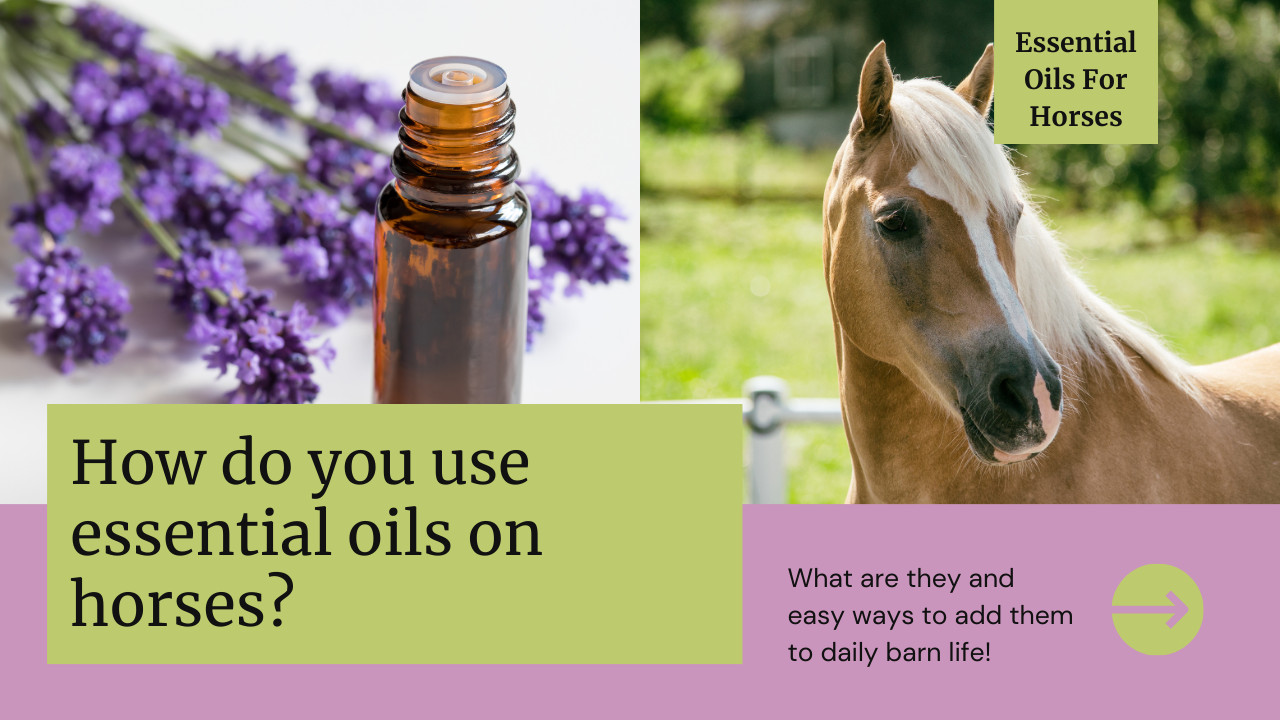
In the realm of natural remedies for horses, essential oils stand out as a versatile and effective option. Derived from plants, these oils offer a holistic approach to equine wellness, aiding in everything from relaxation to skin health. Understanding how to properly use essential oils with your horse is key to their safe and beneficial application.
What Are Essential Oils?
Essential oils are highly concentrated plant extracts. These oils capture the plant's scent and flavor, or "essence," hence the name. Each oil carries the distinctive fragrance and properties of the plant it is derived from.
In plants, essential oils serve various purposes, primarily acting as the plant's defense mechanism against predators, pests, and environmental threats. They also play a role in plant pollination, attracting beneficial insects while repelling harmful ones. Additionally, essential oils can help heal wounds and protect the plant from infections.
How We Benefit:
When we use essential oils, we harness these natural properties for our own well-being. Each essential oil contains a unique combination of compounds that can have wellness effects on the body and mind. For example, lavender essential oil is known for its calming and relaxing properties, while eucalyptus oil is prized for its ability to support respiratory health.
Where Do They Come From?
Essential oils are extracted from various parts of plants, including flowers, leaves, stems, bark, and roots. The extraction process involves steam distillation, cold pressing, or solvent extraction, depending on the plant and its properties.
Three Ways to Use Essential Oils on Horses
- Inhalation: This is the easiest method and the best one to start with and simply means inhaling the aroma of the essential oil.
- Topical Application: Essential oils can be applied topically to your horse. Best practice, especially if you are new to essential oils, is to dilute the essential oils in a carrier oil for application.
- Supplement: Yes! You can give essential oils as a supplement to your horse. You need to read your labels and only use essential oils labeled for ingestion.
Let's dive more into each method with practical ways to incorporate it into your barn life:
Inhalation
Inhalation is a simple and effective way to introduce essential oils to your horse. This method involves allowing your horse to inhale the aroma of the oils, which can have a variety of benefits. You can do this by simply opening the bottle of essential oil near your horse, as their sense of smell is much greater than ours.
Alternatively, you can drop a few drops of oil onto your palms, rub them together, and offer them for your horse to smell. This allows both you and your horse to enjoy the aroma, as you are both part of the partnership.
Another option is to wear diffuser jewelry, which allows you to carry the scent of the oils with you. This way, you can become a walking diffuser for your horse. You can also make your own perfume with essential oils, creating a personalized scent that can benefit both you and your horse. For a quick guide to making homemade perfume with essential oils, click HERE.
If you have electricity available and a more closed barn environment, you can use a diffuser to disperse the oils into the air. My favorite type of diffuser is ultrasonic, which uses water and ultrasonic vibrations to create a fine mist of oil particles. This method is gentle and safe for horses. Check out my favorite diffuser HERE.
If you don't have electricity or a diffuser, you can use wooden clothespins, cotton balls, or even cork stickers available on Amazon to absorb the oils and release the scent gradually.
Topical Application
Topical application of essential oils involves diluting the oils in a carrier oil and applying them directly to your horse's skin. This method is great for targeting specific areas of concern, such as muscle soreness or skin issues.
Essential oils can penetrate the skin and enter the bloodstream, providing localized and sometimes systemic effects. When applying essential oils topically, it's important to dilute them properly to avoid skin irritation.
In general, a 5-10% dilution is adequate for most horses when using essential oils topically. If you and your horse are new to essential oils or trying a new oil, it's wise to start with a lower dilution and observe your horse for any signs of sensitivity. Factors such as your horse's age, size, weight, health, and general sensitivities can all impact the appropriate dilution. For a helpful guide on dilution, you can grab my easy guide HERE.
If you experience a reaction, simply add more carrier oil to further dilute the essential oil and allow your horses body to process it at a slower rate.
My favorite carrier oils include fractionated coconut oil, which is a lightweight, odorless oil that absorbs quickly into the skin.
Jojoba oil is another great option, closely resembling the skin's natural oils and providing excellent moisturization.
Coconut oil, while solid at room temperature, melts easily on contact with the skin, making it a versatile carrier oil.
You can use any carrier oil you prefer, and other products like natural soap, witch hazel, vodka, and aloe vera gel or juice can also be used as carriers. For more information on diluting essential oils for horses with carrier oils, check out my dedicated blog HERE.
Supplement:
Using essential oils as a supplement involves adding them to your horse's feed or dropping them (diluted) into the lower lip. This is an advanced method that allows for internal absorption of the oils, providing systemic benefits. However, it's crucial to use caution when administering essential oils internally, as not all oils are safe for ingestion.
When it comes to using essential oils as supplements, it's crucial to read your labels and only use oils labeled for ingestion, such as my company's Vitality™ line, which you can check out HERE.
Ingesting essential oils can be a controversial topic, but it's worth noting that you and your horse may already be consuming essential oils in the products you buy or have used in the past. Many equine feeds on the market contain essential oils as natural preservatives, and they are also commonly found in human food products.
If you're unsure about ingesting essential oils, there are plenty of other ways to use them, but I encourage you to delve deeper into the topic and not just believe the hype. Make an informed decision based on facts and research.
It's also worth mentioning that many essential oils are listed on the Generally Recognized as Safe (GRAS) list. This list is maintained by the U.S. Food and Drug Administration (FDA) and includes substances that are considered safe for consumption based on available scientific evidence and expert consensus. Being on the GRAS list provides reassurance regarding the safety of ingesting these essential oils when used appropriately.
Additional Application Methods
In addition to inhalation and topical application, there are several other creative ways to incorporate essential oils into your horse's wellness routine.
1. Shampoos and Bath Products: Adding essential oils to horse shampoos or bath products can enhance their cleansing properties and provide a relaxing experience for your horse. For a DIY horse shampoo, mix a few drops of essential oil (such as lavender or chamomile) into the amount you're going to use of a natural, unscented shampoo base. This can help soothe your horse's skin and promote a shiny coat.
2. Sprays: Creating a spray with essential oils is a convenient way to apply them to your horse. Mix about 10-20 drops of essential oil to 2 ounces of water in a spray bottle and shake well before use. You can use this spray to freshen up your horse's stall, bedding, grooming area, or even spray in your horse trailer before travel. Peppermint and lemon essential oils are great for creating an uplifting spray, while lavender and Roman chamomile oils can be used for a relaxing scent.
3. Liniments: Essential oils can be added to liniments to create a soothing muscle rub for your horse. Mix a few drops of essential oil with a natural liniment base (such as arnica or witch hazel) and apply it to your horse's muscles after a workout or strenuous activity. Peppermint and wintergreen essential oils are popular choices for their cooling effect, while lavender and chamomile can help relax muscles. For an easy peppermint brace perfect after a summer ride-click HERE.
4. Grooming Products: Incorporating essential oils into grooming products such as mane and tail detanglers, hoof conditioners, or natural fly repellents can provide added benefits. For example, adding lavender to a mane and tail spray can provide a relaxing aroma and skin and coat benefits. For more help in using essential oils in your grooming routine, click HERE!
When using essential oils in these additional ways, always start with a small amount and monitor your horse for any signs of sensitivity or irritation. It's also important to use high-quality, pure essential oils to ensure effectiveness and safety.
Essential oils can also react with petrochemicals, so it's important to only add them to products with natural ingredients. If your goal, like mine, is to transition away from toxic chemicals and toward a natural approach to horse care, you're not only benefiting your horse but also yourself and the planet!
Safety Precautions
While essential oils can offer numerous benefits for horses, it's important to use them safely and responsibly. Here are some key safety precautions to keep in mind:
Quality Matters:
One of the most critical factors in using essential oils safely is quality. Not all essential oils are created equal, and some may contain synthetic additives or impurities. Read your labels and look for essential oils that are 100% pure.
Regulation of essential oils falls under the U.S. Food and Drug Administration (FDA) specifically in the cosmetic category. There are many 'trade secret' loopholes which means that while an essential oil may be labeled as "100% pure," it may still contain synthetic additives or be adulterated in some way. This is why it's crucial to choose a reputable company that prioritizes quality and transparency.
Some companies may use loopholes in labeling regulations to list their products as "natural" or "pure" while still containing synthetic ingredients. It's essential to do your research and choose a company that is transparent about their sourcing and production practices.
I personally use oils from Young Living™, which offers a Seed to Seal®guarantee. This means that from the planting of the seed to the sealing of the bottle, every step of the production process is carefully controlled to ensure the highest quality. I've even had the opportunity to visit their farms and witness the planting and harvesting process firsthand, giving me confidence in the purity and potency of their oils.
Dilution:
Essential oils are highly concentrated, so it's best to dilute them before use. This practice helps reduce the risk of skin irritation and sensitization. Since these oils are absorbed and processed quickly by the body, it's advisable to apply a small amount of diluted oil more frequently than a large amount all at once. This approach allows you to observe the effects and fine-tune your usage accordingly.
Storage Tips:
Proper storage is essential to maintain the potency and effectiveness of essential oils. Store them in a cool, dark place away from direct sunlight and heat sources. Sunlight and heat can cause the oils to degrade and lose their wellness properties.
Additionally, ensure that the bottles are tightly sealed to prevent oxidation. Contrary to popular belief, essential oils do have a shelf life, and storing them correctly can help prolong their efficacy. For more tips on essential oil storage and usage, check out my blog HERE!
Essential oils can offer a natural and holistic approach to promoting the wellness of your horse. From aiding relaxation to supporting skin health, these oils can be a valuable addition to your natural horse care routine. By understanding the various ways to use essential oils, such as inhalation, topical application, and supplementation, you can safely and effectively incorporate them into your barn life.
Remember to always use high-quality, pure essential oils, and to dilute them properly before use.
If you're ready to dive deeper into the world of essential oils and learn how to use them safely and effectively with your horse, consider enrolling in my course,"Oily Horse Intro." This course is designed to help you start using essential oils with your horse with confidence and ease, without feeling overwhelmed.
You'll learn about essential oils, their benefits, and practical ways to incorporate them into your horse's routine. Join me on this journey to enhance your horse's well-being naturally with the power of essential oils. Sign up now and embark on a new, holistic approach to horse care! Click HERE!
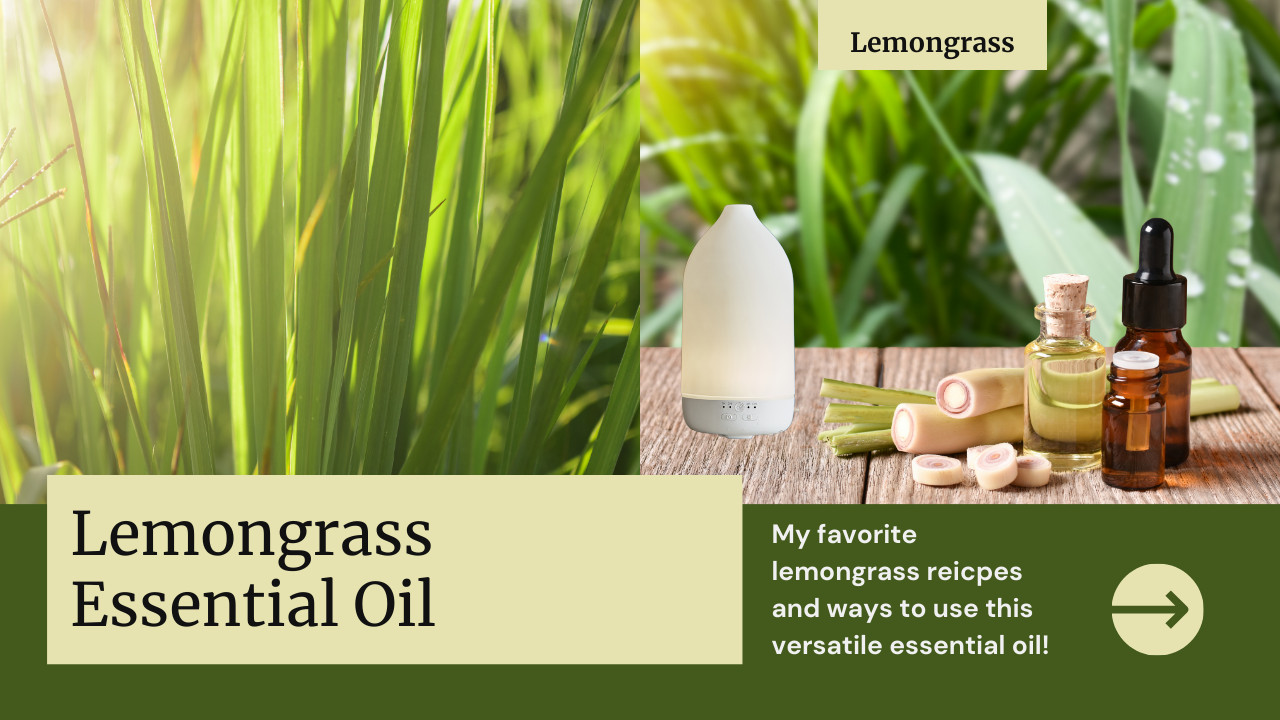
With a bustling household filled with fur kids, I understand firsthand the occasional mishaps that come with the territory. Waking up to the surprise of accidents on the floor is just another day in the life of a dog mom, right? Amidst the chaos, there's one trusty companion I always reach for: lemongrass essential oil. Join me as we delve into the depths of this remarkable oil, unravelling its secrets and discovering why it's become my go-to solution for tackling those inevitable odors. If you want to make your house smell good....even with dogs, read on!
Exploring The Benefits Of Lemongrass Essential Oil:
Lemongrass, scientifically known as Cymbopogon citratus, is a perennial grass native to tropical regions such as Southeast Asia and Africa. Extracted through steam distillation of its leaves, lemongrass essential oil encapsulates the essence of this vibrant grass, exuding a refreshing lemony citrus scent with subtle earthy undertones.
Lemongrass has a rich history of traditional use in various cultures for its medicinal and culinary properties. It was commonly used for digestion, to promote relaxation and uplift mood, and has been studied for its properties rumored to support the body during times of infection. Simply head to PubMed.gov, type in lemongrass, and go down the rabbit hole-lol. Lemongrass has also been a staple in culinary traditions, adding a zesty flavor and aroma to dishes ranging from soups and curries to teas and desserts.
One of my favorite qualities of lemongrass essential oil lies in its ability to banish unwanted odors naturally, making it an ideal solution for neutralizing unpleasant smells in various settings, from household environments to personal spaces. Whether diffused in the air or added to DIY cleaning solutions, lemongrass oil refreshes the ambiance, leaving behind a clean, invigorating scent.
Ever woken up to a less-than-pleasant surprise? Multiple poop piles can certainly dampen the morning mood. I've found my morning rescue in a blend of lemongrass essential oil and cinnamon. With just 2 drops each in my diffuser, the refreshing aroma quickly takes care of 'Eau de poo'. It's become one of my favorite diffuser combos, effortlessly restoring my mornings.
Bid farewell to synthetic air fresheners laden with harmful chemicals and embrace the refreshing aroma of lemongrass essential oil. By simply adding a few drops to a diffuser or homemade room spray, you can transform any space into a sanctuary of freshness. From kitchens to bathrooms, closets to pet areas, lemongrass oil effortlessly eliminates odors while imparting a revitalizing fragrance.
At this point, you might be asking 'Is lemongrass oil safe for pets?'
Absolutely, with a pure essential oil properly diluted, lemongrass can indeed be safe for pets. Dilution ensures that the potency of the oil is reduced to a level that is safe for pets, minimizing the risk of adverse reactions. When used responsibly and in moderation, lemongrass oil can offer benefits such as odor control and help with unwanted pests. As with any essential oil, it's important to only use a pure an premium essential oil and to follow proper dilution guidelines and monitor your pet's reaction to ensure their safety and well-being. To dive deeper in safely using essential oils with your dog, click HERE.
How to use lemongrass oil for odor control:
- Diffusion: Add a few drops of lemongrass essential oil to a diffuser filled with water and let it disperse throughout the room. The refreshing citrus scent of lemongrass will help neutralize odors and leave your space smelling fresh and clean. This also keeps it safely diluted for your dog. Or try some of my favorite diffuser recipes listed below.
- DIY Room Spray: Create your own natural room spray by combining lemongrass essential oil with water in a spray bottle. Shake well before each use and mist the air whenever odors linger. Lemongrass oil's properties will help eliminate odors while leaving behind a delightful citrus aroma.
- Fabric Freshener: Mix lemongrass essential oil with half water and half vodka in a spray bottle. Shake well and lightly spritz this solution onto fabric surfaces such as curtains, upholstery, and carpets to banish odors. The alcohol in the mixture helps the scent to linger longer while the lemongrass oil works its magic.
- Cleaning Solution: Incorporate lemongrass essential oil into your homemade or natural cleaning solutions. Add several drops of lemongrass oil to a mixture of vinegar and water for an effective and natural cleaner that will leave your home smelling fresh without harsh chemical residues.
- Pet Bedding Refresh: Keep your pet's bedding smelling clean and fresh by adding a few drops of lemongrass essential oil to a spray bottle filled with water. Lightly mist the bedding and allow it to air dry. You can also add it to wool dryer balls and dry bedding and blankets.
- Carpet Refresh: Sprinkle baking soda infused with lemongrass essential oil onto carpets and rugs. Allow it to sit for 10 minutes before vacuuming to absorb odors and leave behind a fresh scent. Lemongrass oil will not only neutralize odors but also impart a clean aroma to your carpets.
- Mop Water: Add a few drops of lemongrass essential oil to the water used for mopping floors. The invigorating scent of lemongrass will infuse your home as you clean, effectively eliminating odors and leaving behind a refreshing fragrance. For a double whammy, also add some pine essential oil.
DIY lemongrass oil recipes
Lemongrass Carpet Freshener:
- 1 cup of baking soda
- 10-15 drops of lemongrass essential oil
Lemongrass Room Spray:
- 1 cup of distilled water
- 2 tablespoons of witch hazel or vodka (to help disperse the oil)
- 15-20 drops of lemongrass essential oil
Lemongrass All-Purpose Cleaner:
- 1 cup of distilled white vinegar
- 1 cup of water
- 15-20 drops of lemongrass essential oil
Lemongrass oil diffuser blends for odor:
2 drops lemongrass
2 drops cinnamon
3 drops lemon
2 drops lemongrass
1 drop eucalyptus
2 drops lemongrass
2 drops citronella
2 drops orange
2 drops lemongrass
2 drops kunzea
2 drops orange
Where to buy lemongrass essential oil:
Ready to unlock the refreshing benefits of lemongrass essential oil? Explore my trusted supplier for premium-quality essential oils and embark on your path to a good smelling home today! With firsthand experience witnessing their Seed To Seal guarantee in action, I confidently use pure essential oils with my dogs, horses, and yes-even cats! Click HERE to start your journey.
Feeling inspired to freshen up your space with lemongrass oil? I'd love to hear about your experiences! Share your stories and tips in the comments below.
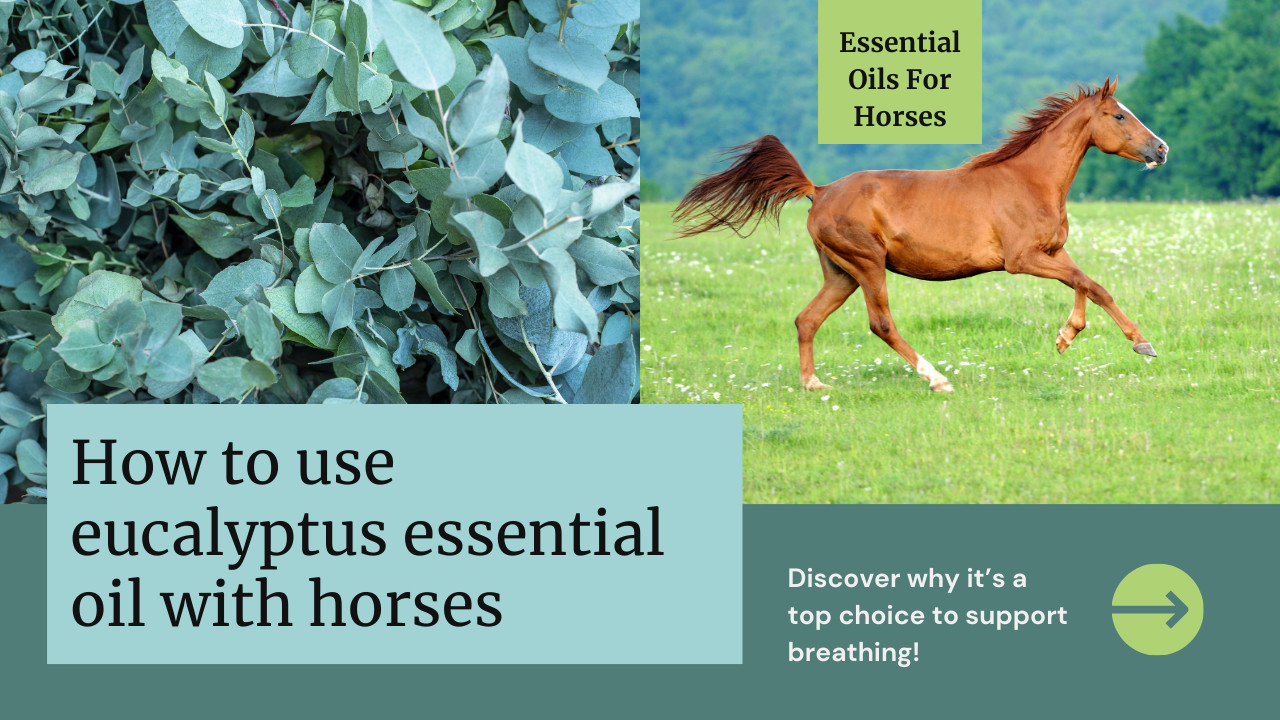
Eucalyptus essential oil is on my mind this week, sparked by a recent experience with one of my horses. As I began a ride last week, I noticed a slight cough emerging. Being an avid enthusiast of essential oils, I instinctively reached for one of my favorites for when I have a cough – eucalyptus! With a dollop of coconut oil in my palm, I added a drop of eucalyptus oil, rubbed my hands together, and gently massaged it into his chest before the next ride. Within just a few days, the cough vanished entirely. This inspired me to share the wellness benefits of eucalyptus oil, one of my favorites to support the respiratory system, prompting the topic of this week's blog.
Essential oils have been utilized for centuries across various cultures for their wellness properties and aromatic benefits. But if you're wondering what essential oils are and where they come from, allow me to provide some insight before diving deeper into the wonders of eucalyptus essential oil.
Essential oils are natural compounds extracted from plants through processes like steam distillation or cold pressing. These concentrated plant extracts capture the essence of the plant, including its fragrance and beneficial properties. Each essential oil contains a unique combination of volatile compounds that contribute to its distinct aroma and wellness effects.
Plants produce essential oils for various purposes, including attracting pollinators, defending against pests, and promoting overall health. The aromatic compounds found in essential oils serve as the plant's defense mechanism and play a crucial role in its survival and reproduction. Essential oils can serve us in many of the same ways they serve their plant.
Now, let's tie this knowledge into our exploration of eucalyptus essential oil. Eucalyptus oil is derived from the leaves of the eucalyptus tree, predominantly native to Australia. With its invigorating aroma and wellness properties, eucalyptus oil has become a staple in natural wellness practices around the world. Renowned for its refreshing scent, eucalyptus oil contains compounds like 1,8-Cineole (eucalyptol), which impart its characteristic aroma and can offer numerous health benefits.
Eucalyptus Essential Oil Benefits for Horses:
- Respiratory Support: Eucalyptus oil is perhaps best known for its ability to support respiratory health. Its invigorating aroma can help support clear nasal passages and promote easier breathing, making it particularly valuable for horses exposed to dusty environments or prone to respiratory issues. This study, found on PubMed.gov, states that “1,8-cineole is a natural monoterpene, also known as eucalyptol. It is a major compound of many plant essential oils, mainly extracted from Eucalyptus globulus oil. As an isolated compound, 1,8-cineole is known for its mucolytic and spasmolytic action on the respiratory tract, with proven clinical efficacy. 1,8-cineole has also shown therapeutic benefits in inflammatory airway diseases, such as asthma and chronic obstructive pulmonary disease (COPD).“
- Soothing Muscle Discomfort: Muscle discomfort is common in horses wether your horse is a backyard pet or an athlete in training. Eucalyptus oil has been studied for natural analgesic and anti-inflammatory properties, making it a fantastic choice for soothing muscle discomfort and joints after activity. This study, found on PubMed.gov, which investigated the effects of eucalyptus oil inhalation on patients who underwent a total knee replacement, showed that eucalyptus oil inhalation was effective in reducing patient's subjective pain and blood pressure after surgery.
- Pest Deterrent: Pests, including flies, mosquitoes, and ticks, seem to avoid eucalyptus. By incorporating eucalyptus oil into your grooming routine or stable environment, you can help discourage pests without resorting to harsh chemicals.
- Skin Help: Eucalyptus oil's antimicrobial properties have been extensively researched, as evidenced by studies available on PubMed.gov. One study underscores its antibacterial efficacy, suggesting its potential as an alternative or adjunct to traditional antiseptics, thereby mitigating the risk of antiseptic resistance(read about that study HERE). Another study highlights the antimicrobial effects of eucalyptus oil and its main component, 1,8-cineole, against a wide range of bacteria (read about that study HERE).
- Tension relief: This study, found on PubMed.gov, found that "1,8-Cineole, a major constituent of eucalyptus, was effective in decreasing anxiety and that inhalation of 1,8-cineole may be used to relieve anxiety before, during, and after various operations." If your horse appears tense or anxious, try offering them the opportunity to inhale eucalyptus oil from the bottle. I've personally witnessed remarkable results with horses exhibiting fear-based behaviors. Simply allowing them to inhale from the bottle until you notice subtle signs of relaxation, such as slower breathing, a lowered head, or changes in posture, can significantly contribute to their sense of calm and trust. It's a simple yet effective technique.
You might be wondering, "Is eucalyptus essential oil even safe for horses?" The answer is a resounding yes, but with some important considerations.
First and foremost, quality matters. Opt for high-quality, premium eucalyptus oil from reputable suppliers to ensure purity and potency.
By the way, if you're in need of a reliable source for essential oils, why not check out my company? They're renowned for their commitment to quality through the Seed to Seal® process, and they're proud pioneers in the industry. Plus, I've personally visited many of the farms worldwide and even had a hand in planting and harvesting. Click HERE to explore a wide range of essential oils and oil infused products!
Additionally, proper dilution is key. While eucalyptus oil can offer wellness benefits, it's potent in its undiluted form and can cause skin irritation or sensitivity in horses. Best practice is to dilute eucalyptus oil with a carrier oil, such as fractionated coconut oil, before topical application. By the way if ya wanna know more about carrier oils and diluting essential oils for use with horses, click HERE.
By prioritizing quality and dilution, you can harness the full potential of eucalyptus essential oil while safeguarding your horse's well-being.
How To Use Eucalyptus Essential Oil With Horses:
Now that we've explored the myriad benefits of eucalyptus oil for horses, let's discuss practical ways to incorporate it into your daily routine:
- Simply let your horse smell it: Introduce the bottle with the lid slightly open to your horse, leveraging their superior sense of smell. Allow them to inhale the aroma at their own pace. Alternatively, apply a drop of eucalyptus oil to your hand along with a dab of carrier oil. Allow your horse to explore the scent, then massage any residual oil onto their chest to promote clear and comfortable breathing.
- Grooming: Add a few drops of eucalyptus oil to your horse's shampoo or grooming spray for an added burst of freshness and pest deterrent power. You can also let your horse sniff from the bottle during a grooming session for some extra calming vibes. If you're making your own fly spray, eucalyptus can be a worthy addition.
- Massage: Create a soothing massage oil by combining eucalyptus oil with a carrier oil and gently massaging it into your horse's muscles after exercise or during grooming sessions.
- Environmental Diffusion: If you have electricity and a closed barn, investing in a quality essential oil diffuser and adding eucalyptus oil will help with odors and freshen the space while promoting good breathing. No electricity, no problem, simply make a spray by adding around 10-20 drops to 2 ounces of water. Shake well and mist where desired. You can also drop a couple of drops on a wooden clothespin and clip around the barn. With horses greater sense of smell, this method works well even in open areas.
Have you ever wondered about the different types of Eucalyptus essential oils available? With my go-to essential oil company offering three distinct varieties, the choice between Eucalyptus Radiata, Eucalyptus Globulus, and Eucalyptus Blue can be intriguing. Let's dive into the nuances of each type to discover which one best suits your equine companion's needs.
- Eucalyptus Radiata: Eucalyptus Radiata, also known as Narrow-Leaved Peppermint, is prized for its milder aroma and versatile properties. It boasts a crisp, clean scent with less of camphorous odor than eucalyptus globulous, making it a popular choice for aromatherapy and respiratory support. When it comes to horses, I prefer Eucalyptus Radiata for its mildness in aroma, especially for sensitive animals or those prone to respiratory sensitivities. It also seems to have a more relaxing aroma to me, making it suitable for promoting clear breathing with more relaxation during grooming or massage sessions, where as eucalyptus globulous is more invigorating,
- Eucalyptus Globulus: Eucalyptus Globulus, commonly known as Blue Gum Eucalyptus, is renowned for its invigorating aroma and potent benefits. It features a strong, camphorous scent with hints of earthiness, making it ideal for respiratory support and muscle relaxation. If you really need to wake the respiratory system up or support better breathing, this is a good one to try. I often use this one in a muscle rub for muscle discomfort, or in a liniment for legs, and also as a worthy addition to my homemade sprays for pests.
- Eucalyptus Blue: Eucalyptus Blue, a unique variety of eucalyptus, stands out for its striking blue-green foliage and distinctive aroma. It's often referred to as blue gum. It exudes a fresh, slightly sweet scent with undertones of mint, offering a unique twist on traditional eucalyptus oils. As with eucalyptus radiata, I find the aroma to be milder than eucalyptus globulous and perhaps a better choice for sensitive individuals. With my horses, if I offer them a bottle of each eucalyptus to pick from, they often will pick this one and I theorize its the sweet mint undertone-haha!
While I do use eucalyptus radiata and eucalyptus globulous interchangeably, if I had to pick, it would be Eucalyptus Radiata simply for its milder aroma. Eucalyptus blue is a tad more expensive, but I really do love the sweet mint undertone. All three have high levels of eucalyptol, which give it its distinct invigorating scent and properties for discomfort, tension relief, and respiratory support.
Eucalyptus essential oil holds tremendous potential for enhancing the health and well-being of our equine companions. From respiratory support to muscle relaxation and help with pests, its versatile benefits make it a valuable addition to any horse owner's natural care toolkit.
Thank you for joining me on this exploration of how eucalyptus essential oil can benefit our equine companions. If you've had any experiences with eucalyptus oil, I'd love to hear about them! Feel free to share your stories and insights in the comments section below.
Looking to harness the power of eucalyptus essential oil for your horse? Click HERE to grab a bundle of all three eucalyptus oils and a carrier oil from my go-to company. With their commitment to quality through the Seed to Seal® process and my personal experience with their products, you can trust that you're providing the best for your horse. Plus, by purchasing through this link, you'll be supporting my efforts to continue bringing you valuable information and resources on natural wellness for horses.
Don't miss out on the opportunity to elevate your horse's well-being with the wellness benefits of eucalyptus essential oil. Click HERE to get started today!
